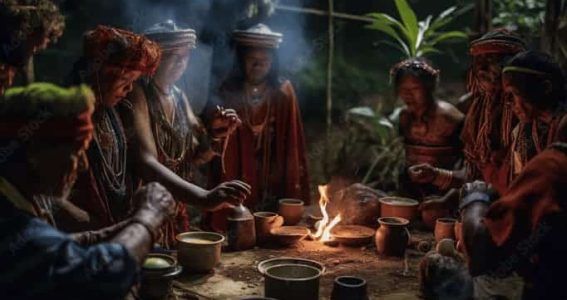
Ayahuasca is a medicinal plant used in traditional Peruvian medicine. Its origin dates back to the indigenous cultures of the region. The preparation of ayahuasca involves the combination of two plants: the ayahuasca vine and the chacruna bush, which contain active components with therapeutic properties.
Ayahuasca has its roots in the indigenous cultures of Peru, where it has been used for centuries in sacred ceremonies and healing rituals. This medicinal plant is a fundamental part of the traditional medicine of various native communities in the Amazon region.
The practice of consuming ayahuasca has been passed down from generation to generation, keeping alive the connection between the plant and the spiritual beliefs of indigenous peoples. For them, ayahuasca is not only a medicine, but also a means of communication with the spiritual world and a tool for healing the body and soul.
Ayahuasca is a medicinal plant composed of several fundamental elements that contribute to its therapeutic effects. Among these components, the Banisteriopsis caapi, also known as the ayahuasca vine, and the Psychotria viridis, the chacruna bush, stand out.
Banisteriopsis caapi: The ayahuasca vine
Banisteriopsis caapi is a vine that contains alkaloids such as harmine and tetrahydroharmine, which act as monoamine oxidase inhibitors, enhancing the effects of ayahuasca. Its preparation is essential in the production of this medicinal plant.
Psychotria viridis: The chacruna bush
The Psychotria viridis shrub, on the other hand, is rich in dimethyltryptamine (DMT), a hallucinogenic compound key to the effects of ayahuasca. It is combined with the ayahuasca vine to enhance its therapeutic and hallucinogenic properties in traditional ceremonies.

Ayahuasca is an ancient plant with deep roots in Peruvian culture. Its therapeutic and ritual uses are a source of interest and study in traditional Peruvian medicine.
Ayahuasca ceremonies and rituals in Peruvian culture
Therapeutic effects of ayahuasca in traditional Peruvian medicine
Los efectos terapéuticos de la ayahuasca van más allá de lo físico, abordando aspectos emocionales y espirituales.
Ayahuasca, used in traditional Peruvian medicine, has a number of benefits and risks that are important to keep in mind when considering its consumption.
Possible mental health benefits
Risks and contraindications of ayahuasca in Peru
In Peru, ayahuasca is considered part of the cultural and spiritual heritage of Amazonian indigenous communities. Its use in ritual ceremonies is recognized and protected by law as part of the identity of these ancestral peoples.
The experience of consuming ayahuasca in traditional ceremonies in Peru is described by many as a profound journey towards spiritual connection and personal introspection. During the process, visions, intense sensations and a deep purification of the body and mind are often experienced.
In general, the experiences and testimonies of those who have tried ayahuasca in Peru highlight the transformative depth of this medicinal plant in the context of traditional ceremonies, emphasizing the importance of respecting its use within the framework of indigenous culture and ancestral wisdom.
Today, ayahuasca has gained popularity in Peruvian culture as a tool for spiritual exploration and personal growth. More and more people, both local and foreign, are attracted by the therapeutic and visionary effects of this medicinal plant.
The presence of ayahuasca in Peruvian society today reflects a resurgence of ancestral practices and a search for holistic healing in a world marked by stress and disconnection.

Ayahuasca has a deep meaning in the indigenous communities of Peru , where it is considered a spiritual and healing tool. Its use in ceremonies and rituals is part of the identity and worldview of these ancient peoples.
In Peru’s indigenous communities, ayahuasca is more than just a medicinal plant; it is a symbol of identity and cultural resistance to external pressures. Its impact extends beyond the therapeutic, permeating all aspects of the daily and spiritual life of these indigenous populations.
Scientific research on the effects and medicinal uses of ayahuasca in the Peruvian context
Scientific research on ayahuasca in the Peruvian context has gained interest in recent years. Various studies have focused on the therapeutic effects of this medicinal plant used in ceremonies and rituals. It has been observed that ayahuasca may have potential in the treatment of mental disorders such as depression and anxiety.
It is important to continue promoting scientific research on ayahuasca in the Peruvian context in order to take advantage of its potential therapeutic benefits in a responsible and safe manner.
Ayahuasca centers and retreats in Peru
Ayahuasca is a sacred plant used in ceremonies and rituals at various centers and retreats in Peru. These places offer the opportunity to experience ancient medicine in a safe and supervised environment. Here you will find information about participating in ayahuasca ceremonies in Peru.
Recommendations for participating in ayahuasca ceremonies in Peru
Education and awareness about responsible consumption of ayahuasca in Peru
It is essential to promote education and awareness about the responsible consumption of ayahuasca in Peru, especially among those who wish to participate in ceremonies and rituals with this medicinal plant.
Raising awareness about responsible ayahuasca use in Peru helps ensure safe and respectful experiences for both practitioners and the indigenous communities that share their ancestral wisdom.
Alternatives and complements to ayahuasca in traditional Peruvian medicine